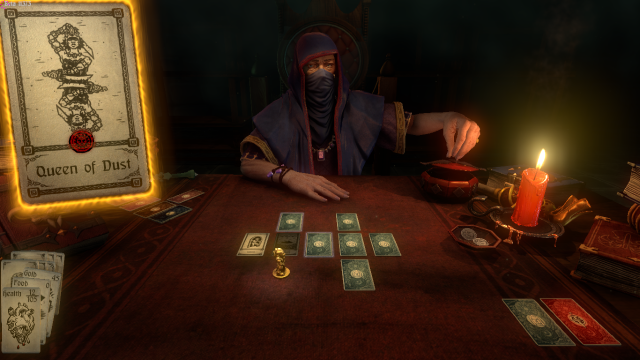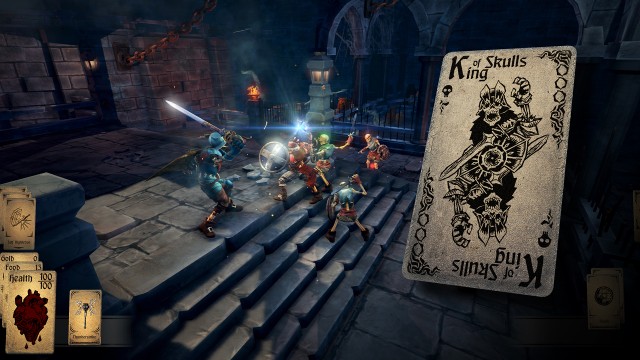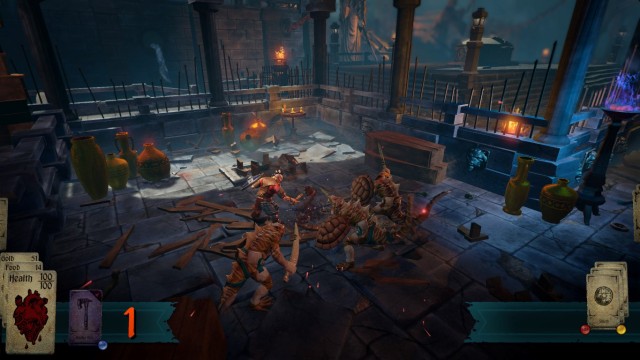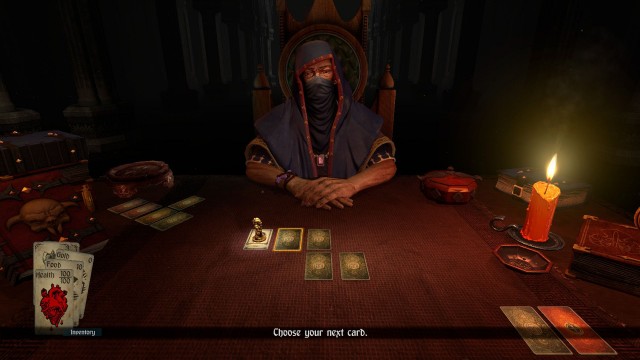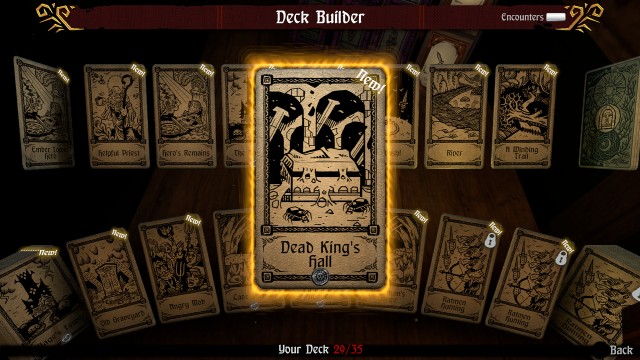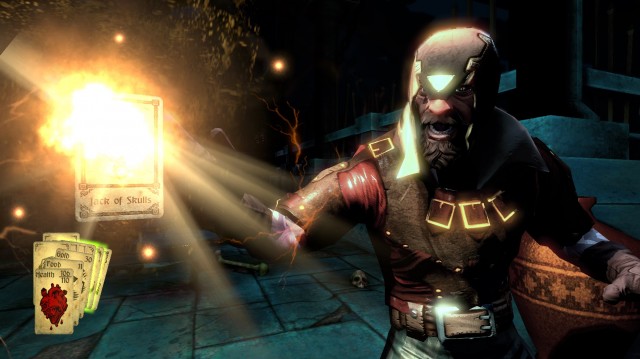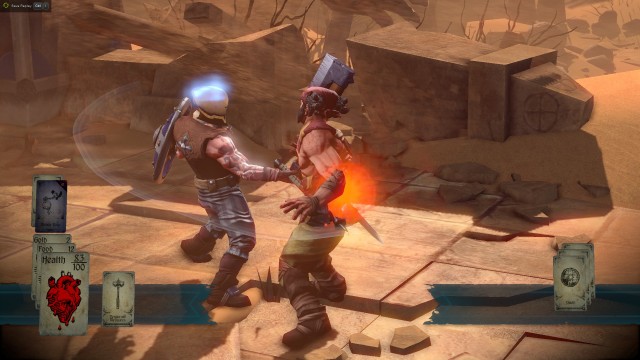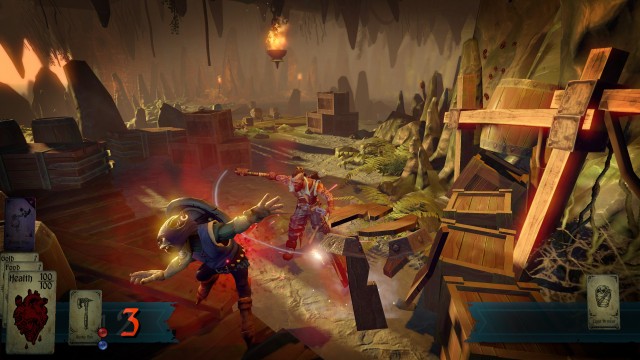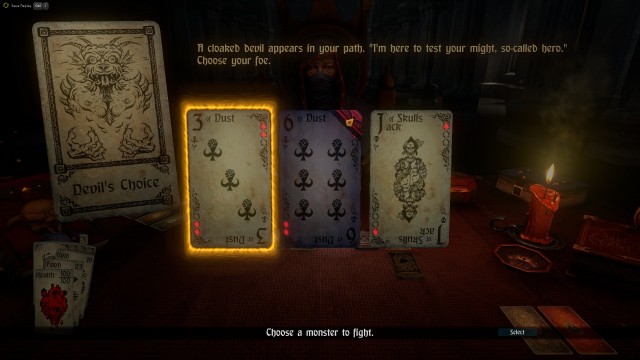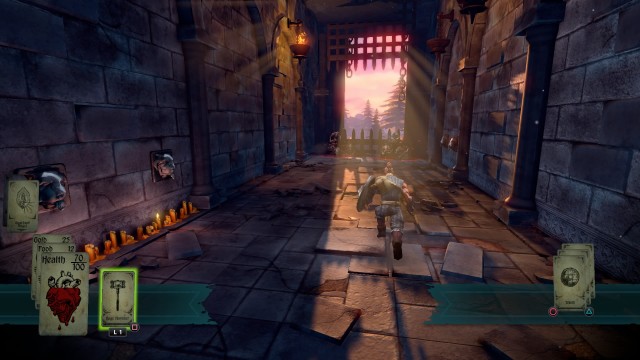A common expression in life is, “You have to play the hand that you’ve been dealt.” That is quite literally true in Hand of Fate, a very novel and interesting concept for a fusion of video games, card games and tabletop games, where fate itself quite literally deals you a set of cards that could bless you or curse you, over the course of an unpredictable, tabletop-style adventure. The idea was originally pioneered on Steam Greenlight, and later approved for Steam Early Access, though eventually ended up expanding to PS4 and Xbox One after the final release of the game dropped on PC, Mac and Linux.
Of course, the best thing about Hand of Fate is that you don’t need any gaming friends, nor any pens or paper to play it. The game is single-player-only, and unfolds in a streamlined style that takes the best of various mediums of gaming, while eliminating the hurdles that things like collectible card games and tabletop games make you jump through. Some may lament the game’s streamlining eliminating a lot of potential depth that you would otherwise find in a good actual pen-and-paper RPG, tabletop game or collectible card game, but this is a small price to pay for a video game experiment that is quite fun, addictive and well-designed!
Being at the whims of fate however, one can imagine that Hand of Fate is not for the impatient, nor for those who crave a sense of control in their video game adventures. A lot of the surprising fun of Hand of Fate comes from relinquishing control, and basing your adventure more on reaction than action. A stroke of good luck and fortune will give you an unparalleled feeling of satisfaction and confidence, though just the same, an unlucky streak can just as easily frustrate and make you feel helpless. It’s all part of the game though, and considering the incredible ambition behind this indie gem, Hand of Fate keeps you coming back, even as the roll of the metaphorical dice can deal some pretty brutal punishment.
Hand of Fate was built from the indie-friendly Unity Engine, and was even partially funded on Kickstarter. Even then though, the game makes the most of its limited visual budget to produce something that looks very appealing and immersive, even without much variation in the environments, at least outside of combat. Most of the time, you will be staring down your enigmatic opponent of sorts, known only as The Dealer, who talks and muses with you about life, fate and your actions, while picking up simply-designed cards that can depict austere-looking pictures of fortune or misfortune.
The way that the game gets around its visual limitations by focusing most of its energy on the immersion of playing against the mysterious Dealer is very smart, leaving a lot of the cards’ passive scenarios to be conveyed entirely through text. It’s a minimalist design that works, with the environments only shifting during combat scenarios, or trap-dodging scenarios. In combat, the viewpoint shifts to a more isometric angle, while the trap sections have more of a top-down view, giving you the best chance of noticing what’s around you. Unfortunately, the combat sequences have a less reliable camera as well, with enemies sometimes able to toss projectiles at you off-screen (though these are at least indicated by visual prompts), and that’s before arenas with occasional traps in them, which the camera often obscures, perhaps intentionally, to keep you on your toes during combat. It would have been nice to have a more reliable camera during fights, but fortunately, you can quickly press a dodge button to roll around and regain your bearings.
There are other slight technical hiccups in the visuals as well, though they vary a bit between platforms. While the game mostly looks and runs the same on every platform, Hand of Fate’s hard-to-read fonts force you to pull very close to the television to read a lot of the cards and narration in the console versions, as if the interface is mostly designed around a PC monitor. On the flip side however, the PC version of the game is arguably the least stable, and will occasionally crash, stutter, or have loading or audio cut out, among other occasional bugs, even after patches fixed some of the stability issues on PC. The console versions also have rare instances of loading bugs and dropped framerates, with the Xbox One version seeming to be the least likely to experience these issues, even though the console builds have also seen patches to make these issues less frequent. Finally, the game’s load times can be a little long on all three platforms, considering its modest graphics, and this can be a nuisance when you’re frequently going in and out of combat, and especially when you’re visiting shops.
Mostly though, Hand of Fate is very well-produced from a visual standpoint, having nicely detailed character models, and a simple, but engrossing presentation. The wonky camera and occasionally stuttering animations sometimes disturb the combat sequences, but Hand of Fate is nonetheless one of the more polished indie games that spawned from the Unity Engine.
Like the visuals, the audio in Hand of Fate is modest, but effective. The music mostly consists of Middle-eastern-themed strings, giving the game a sort of exotic, fortune teller-esque feel, which works well with the presentation. Even combat mostly consists of this same string-heavy soundtrack, though the exciting and catchy combat tunes still work pretty well, even if the game doesn’t have many variations on the battle theme, and cycles between the same couple of compositions, even during boss encounters.
Sound effects are satisfactory, though only a handful of them stand out as being especially powerful. Combat can sometimes feel a little lightweight, though the game’s mightier attacks at least sound with the proper punch and fury. It’s especially satisfying to hear a triumphant, “Clang!” sound when you fell the last enemy in a combat scenario as well, which often accompanies a nice series of rewards for your deck of benefits. In fact, the audio cues for fortune and misfortune are some of the highlights of Hand of Fate’s sound design, as triumphant bell ringing signals blessings and fortune, just as harsh chords exacerbate failures and bad results. It makes every decision have an immediate emotional impact on the player, and keeps the thrills of leaving your fate in the hands of lady luck especially exciting!
While Hand of Fate is mostly told through unspoken text, there is some voice acting in the game, which comes exclusively from The Dealer, with your unnamed player character being silent. A few of the human enemies will occasionally grunt and let out battle cries, but mostly, it’s The Dealer who will be engaging you during the game. Not only is the voice acting behind The Dealer very good, as he sounds very aged and detached, yet also witty and jaded, but the writing behind his lines is very good as well. Occasionally, The Dealer will try and get in your head by talking about the other players who failed, or questioning a shuffling of your equipment or items. As you play through the game, he also becomes increasingly desperate, gradually losing his wit, and becoming more aggressive and harsh with every round. It’s a great realization of a character that the game mostly leaves up to your imagination, and the cheeky fun of The Dealer is another thing that will motivate players to keep playing, even after an especially bad hand knocks them out of the game.
The only noticeable weak spot in the audio is the occasional cut-outs that mostly seem to be limited to the PC version on rare occasions, but it’s possible that you may never even encounter one, even if you opt to play from Steam. The audio may not aim particularly high, but it also doesn’t over-extend itself beyond its means, delivering a tight presentation for Hand of Fate overall, which does whatever it has to in order to keep players engrossed in the experience, and succeeds.
The gameplay element is the most interesting part of Hand of Fate, particularly since it’s very difficult to easily describe. The game serves as a hybrid between action-RPG (albeit without a leveling system), collectible card game, tabletop game, dungeon-crawling roguelike, and resource management sim. It sounds extremely complicated, but one would be very surprised at how simple and accessible the gameplay actually is, especially since you can opt to have the game take care of your deck management for you between play sessions, if you find that element to be overwhelming.
Hand of Fate is primarily divided into two modes, with those being Story Mode, and Endless Mode, though Endless Mode isn’t unlocked until you’ve proceeded around halfway through Story Mode. Story Mode will have you taking on thirteen tiers of monsters at the end of thirteen different styles of adventures, with each getting progressively more treacherous as you acquire more cards, and complete more optional events to earn you more Tokens, which in turn grant you more cards to play with after a round is completed, regardless of whether you win or lose. Endless Mode meanwhile, true to its name, does not have an end boss, and will instead simply unfold until the player is ultimately defeated, with their times and scores tallied, in an effort to outlast the challenges of The Dealer for as long as they can.
Despite its moniker, Story Mode doesn’t actually have much of a story behind it. Most of the game’s lore is left to the player’s imagination, with Story Mode mainly serving as a way to accrue more cards as you take on the lieutenants of The Dealer. The real meat of the game seems to lie in Endless Mode, where you take on events that are held in the cards to your heart’s content. Hand of Fate is a very simple gameplay package, even in Endless Mode, but its motivation of continually striving to earn new cards for new encounters and new advantages will keep players busy for quite a while, especially with DLC options that add even more cards, and even more ways to play!
So how is Hand of Fate played then? Well, at the start of a round, players customize two separate decks of cards, one for equipment and items, and one for encounters and events. The Dealer also has a deck, where he may dole out Blessings and Curses that are unlocked as you play further in Story Mode, with the former giving you an innate advantage, while the latter gives you an innate disadvantage. As I said, if you find deck management to be overwhelming, you can simply press a button in the Deck Menu to have the game make a competent deck for you, even if avid collectible card and tabletop game enthusiasts will savour the chance to customize their own potential for encounters and bonuses during gameplay.
When the cards are selected on both sides, the game begins, with a certain amount of Encounter Cards placed on a dungeon-like path, which is where Hand of Fate resembles a roguelike game. Players move a figurine, representing themselves, to any adjacent card, which, being face-down, could be an enemy encounter, a chance to acquire new items or equipment, or a special event that may or may not work in the player’s favour. Players proceed along these cards until they find the ‘Exit Card’, which takes them to the next ‘floor’ of the round, and the process starts over, until the player is either defeated, or, in the case of Story Mode, locates and defeats the boss.
Event Cards will often involve the player making choices, which will sometimes immediately result in a reward or a penalty, though will often involve the player drawing a series of cards representing ‘Success’, ‘Great Success’, ‘Failure’ or ‘Huge Failure’, which are shuffled and randomized. Depending on the outcome that the player draws, they might get a reward (or several), or suffer a punishment (or several), which may simply involve not getting their hands on whatever reward they could have gotten for participating in an event. Not only do successful events give you a chance to better turn the odds of the game in your favour, but they’re also the primary way to earn Tokens, which is how you add more events with more possibilities for better equipment and bonuses later in the game.
This element of chance can be thrilling, without completely taking away a sense of skill from the player. Given that each step through the cards that you take consumes 1 Food Card, and will eat at your health when you run out of Food Cards, resource management becomes a factor on your adventures, particularly since good or bad events can also drastically affect your Gold Cards, which are necessary to spend on better equipment, buying food, healing your wounds, or removing Curses. Carefully managing when to be charitable, when to wander, and when to stay focused on an objective, is a way that Hand of Fate avoids devolving into a simple roll of the fickle dice, giving the player some means to play it well, without making the experience too complex and unapproachable.
With that said though, the basis on chance is just prevalent enough to frustrate at times. Even a bit of bad luck, especially later in the game where The Dealer is all too happy to load you with debilitating Curse Cards, can seriously cripple your run. A few bad cards can find you without resources, with your weapons blunted, and with barely any means of proceeding forward, and the player has little to no control over this. Sometimes, you’ll be incredibly fortunate, and get far on some lucky draws, though other times, you’ll be doing great, only to get pounded into the dirt and lose because the game decided to arbitrarily screw you over. The way that the game can ruin a perfectly good run seemingly out of nowhere can be undeniably infuriating, even if it doesn’t change the fact that Hand of Fate remains addictive, and always invites repeat plays, without discouraging you from returning.
The game’s combat scenarios are also questionably balanced at times, especially given the unreliable nature of the camera during these sequences. Individually, the enemies are finely crafted and fun to fight, with combat being a largely straightforward rip of the free-flow combat mechanics first pioneered in the Batman: Arkham games. Players use one button to attack, another to counter blows or deflect projectiles, and use another button in conjunction with the left stick to dodge, while reserving the remaining button to shield bash and stagger enemies that are attempting to block attacks. You can get through most of combat by relentlessly attacking and constantly dodging, and while the enemy design is well and good, there isn’t much to the combat element of the game, which feels like it’s not as tightly-designed as the card mechanics are. You do have special attacks and magic to use, though these aren’t based on a limited supply of MP, and simply recharge after you use them, even if they can do interesting things like slow down enemies, or use crowd-controlling energy bursts to vary combat.
Making matters worse is that the game’s enemies primarily seem to be designed to be taken on in small groups. Later in the game, you’ll take on large groups of ten or twelve foes at once, and when all of those foes are constantly throwing projectiles and charging you, it can be overwhelming to manage them all, especially with the very high rate that you’ll need to dodge and counter attacks. The late-game boss battles are especially troublesome, as new enemies spawn, and lesser enemies sometimes can’t be defeated without defeating the boss first, quickly making combat feel overly chaotic and drawn-out.
You have almost no means of directly healing yourself in combat proper either, even if you do slightly heal some HP with every step you take outside of combat, assuming you have a Food Card to eat, and the lack of healing options makes combat even more frustrating at times. There are special cards that you can find and equip to give you small healing boosts under certain conditions, but it might have been nice if Hand of Fate featured some sort of Health Potion cards or something to stockpile, to avoid combat becoming too annoying or unfair, which it sometimes is towards the end of Story Mode. As if that weren’t enough, losing all of your health and dying will kick you right back to the start of whichever round of Story Mode you were playing, or Endless Mode in general, in the case of that. There’s no mid-round checkpoints, so every decision you make and every step you take is important!
Fortunately, you can help give yourself a fighting chance by finding and equipping Equipment Cards, which can be given to you from successful events, or from spending Gold Cards to purchase in shops. Like the gear awarded to characters in an RPG, Equipment Cards allow you to equip weapons, shields, armour and accessories to improve your offensive and defensive capability, as well as grant potential new benefits to both combat and exploration. There’s no limit to the amount of Ring Cards (accessories) that you can equip either, even if you can only have one Weapon Card, Shield Card, Helmet Card and Armour Card active at any one time, giving you some fairly interesting ways to customize your battle strategy. The need to seek out better equipment from the get-go can be thrilling, as you always start out with a basic axe, armour and shield at the beginning of a round, and this also provides further incentive to explore and participate in events, so you’re better able to deal with greater threats later in the round.
It’s amazing how well Hand of Fate manages to cherry pick quality ingredients from so many separate genres and gaming methods, yet makes its gameplay compelling and easy to understand, even to uninitiated gamers. The hefty inclination towards rotten luck and misfortune later in the game can make the final reaches of Story Mode a bit more of a slog, but whatever frustration you feel at an unlucky run will dissipate and make you want to come back, after a short while of putting the game down. The rules of Hand of Fate are remarkably easy to grasp, and the game does a good job of easing you in, before giving you greater challenges later, particularly as you attempt to finish Story Mode, and survive Endless Mode. It’s a fine example of an experience that’s easy to learn and hard to master, and while luck won’t always be on your side, you’ll never feel like you’ve hit any walls either, since your next round with The Dealer always has the opportunity for better fortune in each play session.
Hand of Fate is an incredibly creative and rewarding experience, and while it serves as a simplified version of a tabletop game or collectible card game, it’s still a lot of fun, and highly memorable. Being at the mercy of luck, or fate as it were, might turn off some players who don’t like giving up a sense of complete control in their gaming, though the game’s luck emphasis fortunately avoids feeling too unfair or annoying, even though the game balance definitely seems slanted toward fortune in the early rounds, and misfortune in the later rounds.
Like I said, regardless of how any given play session with The Dealer turns out, you’ll never be able to guarantee the same result within the cards. An especially great run could be followed by an embarrassingly pitiful one, and vice-versa. The gameplay foundation of Hand of Fate may be simple, but it’s fun and elegant, and proves very difficult to put down. No matter how badly you lose, the loss is never permanent, just like any victory is never truly permanent. Sure, you’ll no doubt experience some degree of repetition if you play through the same cards in Endless Mode after a certain length of time, but most of the time, the unpredictable thrills of Hand of Fate’s gameplay prove to be very novel and enjoyable, since it’s impossible to know how any given round will unfold.
You’ll have to put up with some small bugs and technical hiccups on all three platforms, but regardless of your platform of choice, Hand of Fate is a well-presented game that serves as another success story for both Unity Engine and Kickstarter. Even with its occasionally unrefined combat and possibility of suddenly ending your run with just a bit of bad luck, Hand of Fate is a great testament to the surprising creativity and novelty of indie games, managing to create something enjoyable, if occasionally annoying, from a series of disparate ingredients that no major game company would ever think to try and mix.

